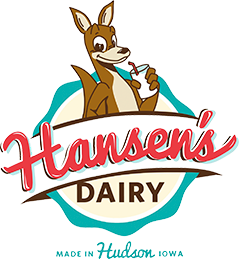Legen-‘dairy’ legacy comes full circle with Superman calf
August 8, 2024 7:56 am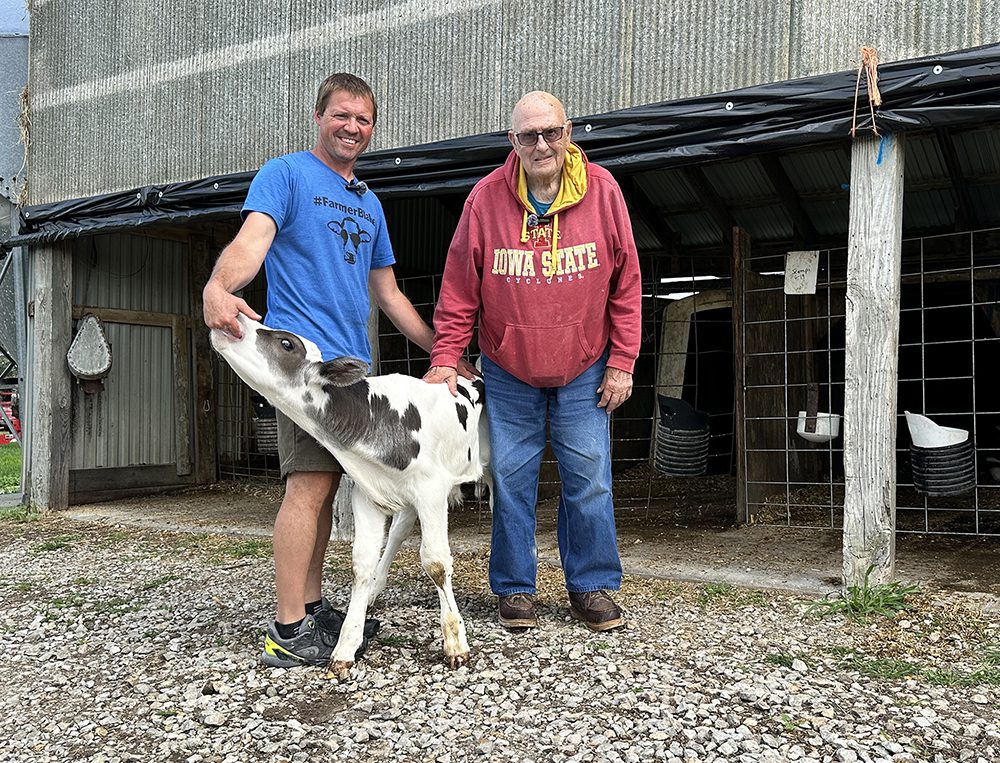
Hadwen Kleiss, age 93, stands with Blake Hansen and a calf that was produced with semen from Kleiss’s prized bull of the 1980s.
By Meta Hemenway-Forbes, Hansen’s Dairy Marketing Manager
Hadwen KIeiss made his way across the gravel to the 12-day-old dairy calf. Just days before, the 93-year-old farmer from Fredericksburg had received a call about a noteworthy bull calf born at Hansen’s Dairy Farm in Hudson.
Accompanied by his grandson, Kleiss made the hour-long drive to lay eyes on the calf named Superman. It was a full-circle, legacy moment punctuated by three words: “I’ll be darned,” Kleiss said.
“I knew this calf was special,” said Hansen’s herd manager and sixth-generation dairy farmer Blake Hansen. “I had to call Hadwen to tell him. He was just so excited.”
The bull calf’s unique silver markings and sturdy build earned him a superhero’s name. But it’s the remarkable genetics of Superman, born June 28, that made him a standout — and piqued the interest of Kleiss.
THE BULL OF ALL BULLS
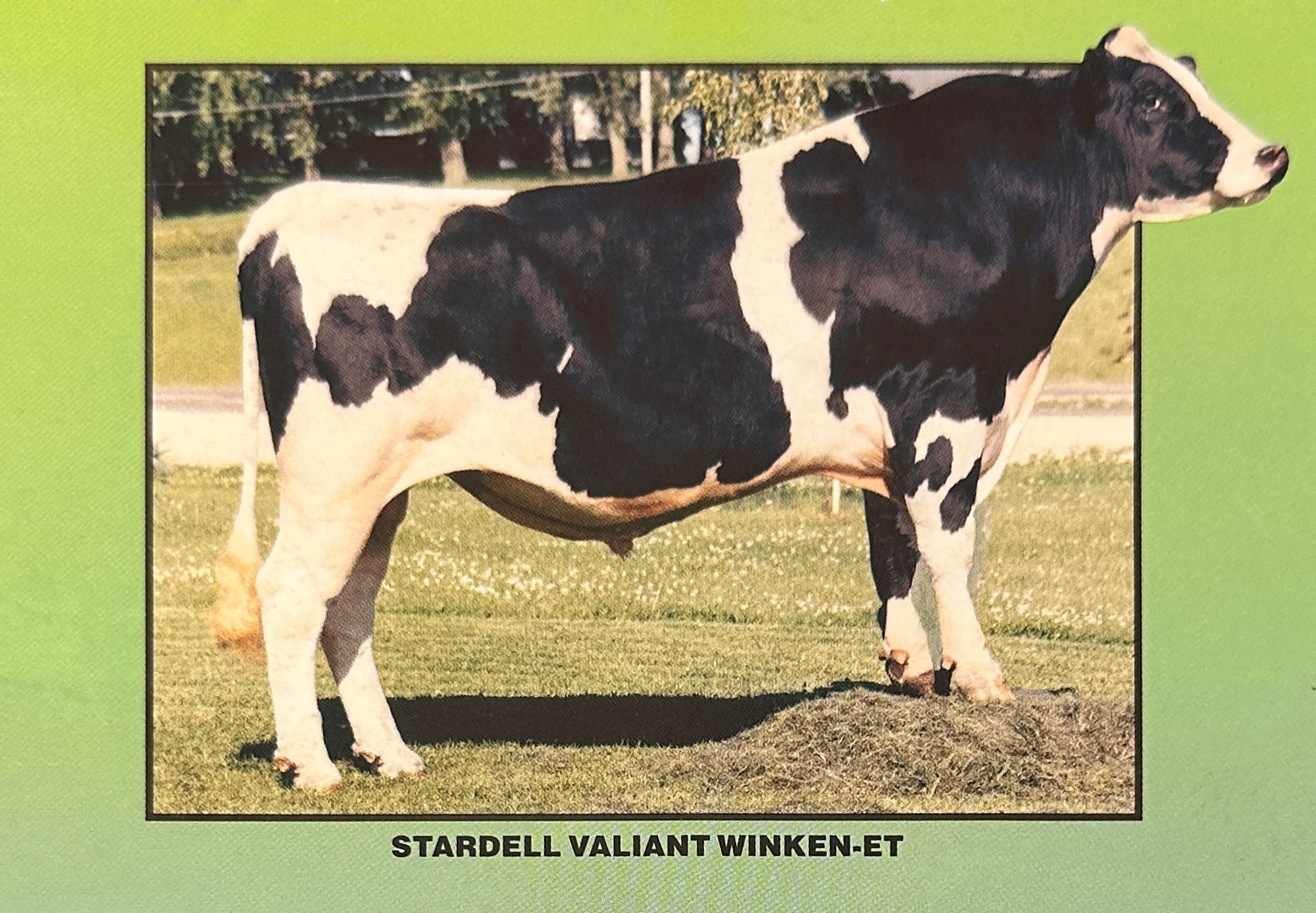
World-renowned Holstein bull Stardell Valiant Winken was born in 1981 on Hadwen Kleiss’s farm in Fredericksburg, Iowa.
Superman was born via artificial insemination to mom Superior. His sire is the world-renowned Stardell Valiant Winken, a Holstein bull born Aug. 7, 1981, on Kleiss’s farm. The now-late “Winken,” as he became known to dairy farmers around the globe, was one of the most prolific, in-demand sires in dairy industry history. Among other superior traits, Winken was known for his daughters’ easy calving.
“He was called a high-impact sire,” Hansen said. “Although he was capable of producing show winners, his strength was producing daughters with high-protein, high-fat and high-volume milk. They were cows that producers liked because of their stature — short with good udders and good conformation.”
According to the book “The Dairy Cow Today: U.S. Trends, Breeding and Progress Since 1980,” Winken “may lay claim to being the most popular and influential bull of this period.”
For more than four decades and even long after his death, Winken has sired dairy cows all over the world, including the United States, Belgium, France, Netherlands, Hungary, India, Korea, Japan, Luxembourg, Portugal, Saudi Arabia, South Africa, Spain, the former Yugoslavia, Zambia and Zimbabwe.
“That’s a lot of countries he was exported to,” Kleiss said.
But perhaps Winken’s biggest accomplishment was saving the Fredericksburg farm that raised him.
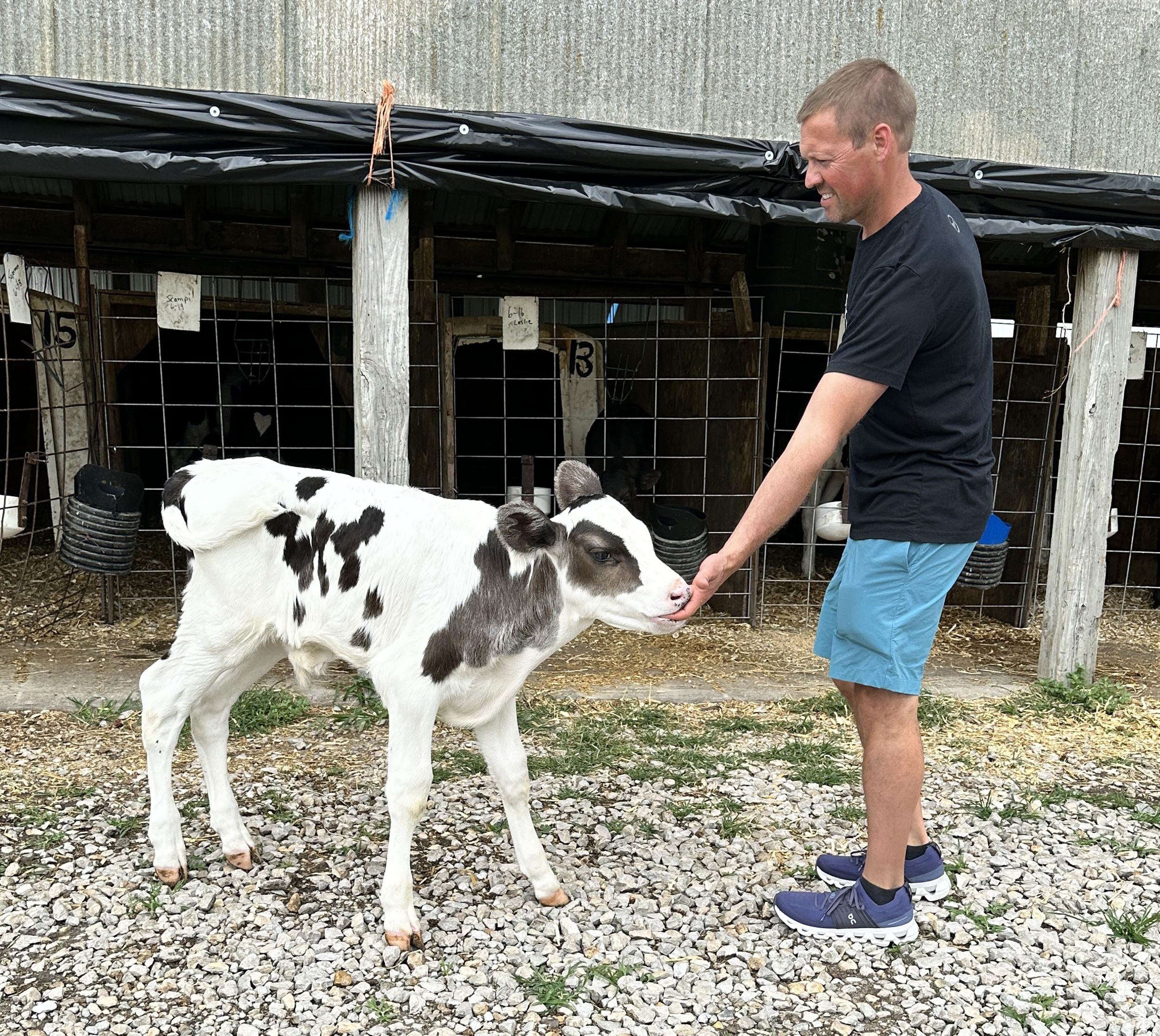
Bull calf Superman, born June 28 at Hansen’s Dairy, was sired by the late Stardell Valiant Winken, one of the most influential bulls in dairy industry history.
FARMS IN CRISIS
Kleiss is the fifth of seven generations to farm the family’s Fredericksburg land. He was born Nov. 13, 1931, in his mother’s childhood home there. It’s a story he loves to tell.
“My mother was in labor for hours. They didn’t think I was gonna make it. But I was born on the kitchen table. They had to go in and grab me by the head. That’s why I ain’t got any brains,” he said, laughing.
Kleiss saw early success growing his dairy and acquiring farmland. Then, during the Farm Crisis of the 1980s, a confluence of factors put an estimated 300,000 family farms in default on loans. By the end of that decade, more than 250,000 of those farms had gone out of business, Iowa PBS reported.
Midwest farms were hit hard. Kleiss, too, was in the red.
“I wasn’t making any money anymore. I couldn’t make my bills,” he said. “We were worried we would have to foreclose. Winken saved the Kleisses.”
SAVING GRACE
As a young farmer, Kleiss had done well in his dairy breeding operations, producing a few solid bulls. He sold his first good bull outright. Then he acted on advice from a fellow farmer — and some divine intervention.
“That farmer said, ‘No, you don’t sell the bull. You want to have royalties,’” Kleiss recalled. “He said he gave 10 percent of his royalties to the church. So I was sitting in church one Sunday and I said, ‘God, I’ll give you 20 percent.’”
Kleiss began to see a pattern of powerfully built Winken offspring and followed his friend’s advice to sell the semen, not the bull. As word of Winken’s superior traits spread worldwide, royalties surged.
The bills got paid. The Kleiss farm was saved. And the farmer kept his promise to the church.
END OF AN ERA

One of three last known remaining Stardell Valiant Winken semen units.
It’s unknown exactly how many daughters Winken sired. “Oh hell, maybe 40,000,” Kleiss said.
It’s also unclear exactly how long Winken lived. The semen used to sire Superman was collected in January 1996. Winken would have been 14 at that time.
Hansen, now his dairy’s herd manager for more than 20 years, taps his network of fellow dairy farmers to find sires from what he calls “old genetics” — bulls born at least 15-20 years ago. He believes older generation bulls were built stronger and sturdier than modern-day sires.
“I was only 3 years old when Winken was born. When I was in elementary school I remember my dad milking some of Winken’s progeny. I remember how much I liked them and how well built they were,” he said. “A couple years ago I started asking around for some Winken semen. Nobody had any. Then, lo and behold, I found this guy in Pennsylvania that had three units. I bought all of them.”
They are the last known remaining Stardell Valiant Winken units.
“It’s sad to think about when they’re all gone because that’s the end of an era. I have two (units) left and I’ll use them sparingly on just the right cows. When it’s gone, it’s just gone,” Hansen said. “But if it has to end, it’s nice to see it happen so close to where it started.”
“It’s really something,” Kleiss agreed.
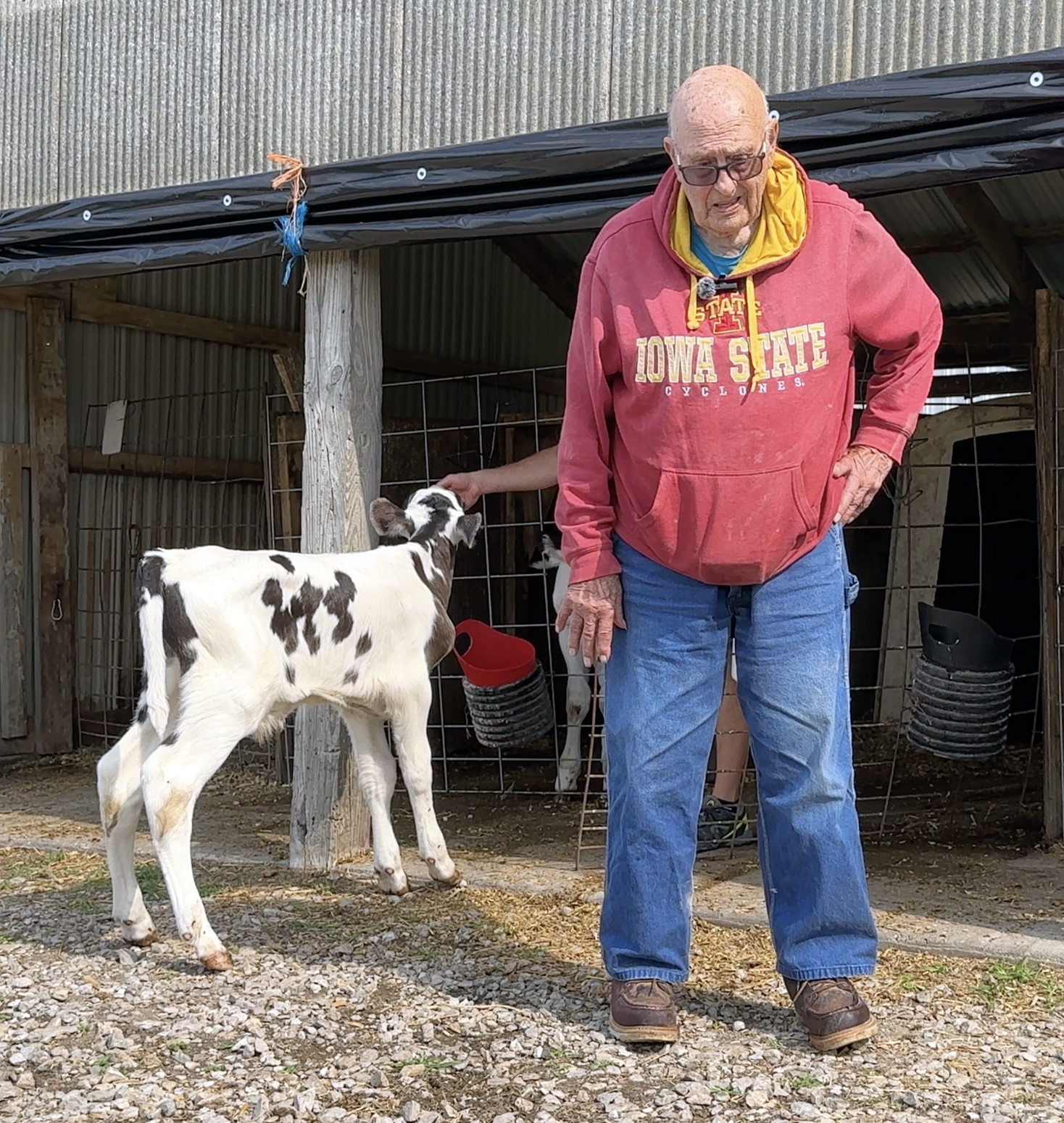
Hadwen Kleiss met bull calf Superman at Hansen’s Dairy.
LASTING LEGACY
As Winken’s legacy endures, so does that of Kleiss. The lifelong farmer is a champion of his community and the dairy industry. He served on industry boards and committees and was inducted into the Holstein Association Hall of Fame in 2000. Kleiss was also featured in the Grout Museum District’s Voices of Iowa project. A Superman in his own right.
As Hansen opened the gate and bull calf Superman emerged, Kleiss didn’t let his excitement get in the way. Ever the dairyman, he gave a thorough, no-bull appraisal of the frisky calf. “He really doesn’t look like a Winken. He doesn’t have that tremendous strength in the front end. Nice rump calf he is, though.”
Seeing the continued fruits of his labor so many years later is rewarding to him as a farmer, Kleiss added.
“It makes me feel good. Being 93 years old I don’t know how long God’s gonna let me stay, but this is really satisfying to see.”

